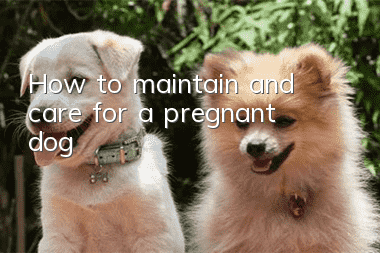How to maintain and care for a pregnant dog

For dog owners, it is exciting and happy to welcome the puppies that are about to be born. However, many people do not know how to care for dogs during pregnancy. , female dogs are weak during pregnancy and need more care from their owners. Let’s take a look at the dog’s pregnancy care!
1. Early pregnancy (4-5 weeks)
Most dogs will gain significant weight in the early stages of pregnancy, and the rest will be the same as usual. The following symptoms will appear after three weeks:
· Increased appetite
· Nipples turn black
· Eliminate vaginal secretions (about the fourth week)
· Reduced exercise
· Morning sickness behavior
After 22 days, the fetus gradually takes shape. At 28-30 days, the doctor can see the image of the puppy and detect the heartbeat through ultrasound, and can also conduct blood tests to obtain hormone levels. Parents can feel the puppies by touching them with the assistance of a doctor (excessive force can cause the dog to miscarry).
2. Second trimester (6-7 weeks)
· Significant weight gain
· Frequent urination
·Abdominal enlargement
· Decreased appetite (after 6 weeks)
· Puppy movements visible in the abdomen
Around day 45, fetal hair grows and bones increase in strength; doctors can check the fetal bone structure (including the number of fetuses) through X-rays.
3. Late pregnancy (8 weeks to 9 weeks)
· The nipple discharges milky white fluid
· The fetus enters the birth canal and the waist shrinks
· Body temperature decreases 12-24 hours before delivery
· Appearing uneasy behaviors such as pacing, panting, shaking, or digging
Around day 57, the fetus is basically fully developed and is waiting for delivery. (If a caesarean section is required, the doctor can determine the best time through X-rays around day 55)
The period from the beginning of a female dog’s pregnancy until she gives birth is the most difficult period.Any carelessness may cause miscarriage, which is extremely harmful to the female dog and may even require removal of the uterus to survive.
Phenomena and causes of miscarriage
During the development of the fetus, the fetus may be directly affected by progesterone deficiency in the female dog (usually due to incomplete formation of the corpus luteum in pregnancy or early degeneration of the corpus luteum), heart failure (such as heartworm disease, fatty heart and other diseases), and circulatory system disorders. , causing it to be hypoxic and causing fetal death), infectious diseases (the most common one is Brucella infection in dogs, followed by Staphylococcus, Escherichia coli, Salmonella and canine distemper virus), trauma, medical errors and improper feeding. Interruption of pregnancy, resulting in miscarriage.
Note: Dogs are infected with Brucella bacteria. It is highly infectious, especially in beagle dogs, which are most susceptible to infection and can be transmitted to humans and can cause miscarriage in pregnant women.
Once symptoms of vaginal bleeding occur, go to a nearby hospital for treatment immediately. Generally speaking, however, miscarriages in dogs are much less common than in other large and medium-sized animals. Of course, parents must also take careful care during pregnancy, so as to avoid the problem of "protecting the child and the child".
Pregnancy care and precautions
1. Diet
· Early pregnancy. A normal diet, without adding any nutrients to an already adult dog's food, will overload the bitch.
· Second trimester. Eat small meals frequently and increase food intake according to the number of fetuses. Female dogs with a small number of babies only need to increase their feeding amount by 30%, while those with a large number of babies need to increase by 60%; dog food can be marked with "growing", "puppy" or "pregnant" (puppy dog food is also acceptable) Wording food. (This type of dog food meets the high nutritional intake required during pregnancy)
· Late pregnancy. In order to promote milk secretion, female dogs must consume some high-quality protein (eggs, meat, etc.) and supplement vitamins, minerals and calcium.
2. Hygiene
· Early pregnancy. Do not take a bath in the first two weeks after mating. You can wipe it with warm water and be careful of catching a cold.
· Second trimester. You can take a bath to keep it clean, but you should do it gently and protect your dog's breasts. (Keep warm in winter)
· Late pregnancy (before delivery). When the female dog is not stressed, you can give her a bath and clean the hair on her abdomen (to facilitate breastfeeding) and pubic area (to prevent postpartum infection).
3. Others
· Maintain an appropriate amount of exercise and avoid strenuous activities (climbing stairs, etc.) to prevent the female dog from becoming overweight.
· Two-thirds of a female dog’s weight gain comes from fluids in the fetus, placenta and uterus.
· Deworming can be done normally during pregnancy and will not affect the fetus
After the female dog is in estrus (1-2 months, including neutered), due to hormonal imbalance, especially progesterone and prolactin, a pseudo-pregnancy phenomenon similar to pregnancy will occur, which can last for more than a month in severe cases. No treatment is required. It is recommended to supplement hormones or remove the ovaries and uterus (for non-neutered female dogs) and reduce milk intake to avoid stimulating extended nursing care or licking behavior.
- Can dogs get arthritis? What causes dogs to get arthritis?
- How to help puppies increase their resistance? A must-read for novices!
- Diagnosis, prevention and treatment of periodontitis in dogs
- Diagnosis and treatment of kennel cough
- Paralysis rehabilitation methods for dogs
- In early spring, when dog parvovirus is most prevalent, how to prevent dog parvovirus?
- Elderly dogs are in pain and cannot tell! Understand the common diseases of dogs in old age and help them live a happy old age
- Look, hear, ask and feel Pet massage & acupuncture
- To make a Chow Chow a domestic pet, you need to master this knowledge first
- Dog won't eat or drink, loses energy and vomits



